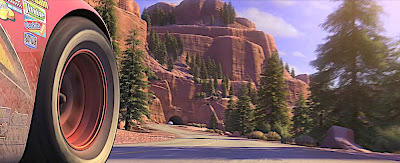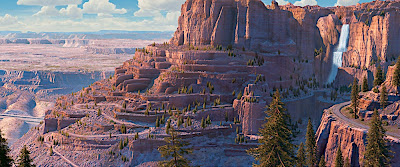
the past twenty years, Pixar Animation Studios has become the vanguard of computer animation and continue taking advantage of almost unlimited technical resources to create new stories and characters that delight the public. From his first Oscar ®-winners and nominees from films to feature the first CG (computer generated images), "Toy Story, Pixar has never rested on its laurels. Each film has been a new challenge. In "A Bug's Life" (Bugs) were the blades of grass and the crowd scenes in "Toy Story 2" caricatured but realistic humans in "Monsters, Inc." (Monsters, Inc.). furry characters and simulated clothing, in "Finding Nemo" the brilliant underwater world, and "The Incredibles" (The Incredibles) filled environments action. His latest film, "CARS", stated one of the biggest challenges to date.
Under the supervision of associate producer Tom Porter, supervising technical director Eben Ostby, and the usual group of technical wizards at Pixar "CARS" started many revolutions and achieved some major milestones on the road.
Perhaps the biggest challenge of the technical team "CARS" was created and painted metal surfaces of the characters in the cars and the reflections that generate these surfaces. At Pixar, we used first algorithmic technique called "ray tracing" for filmmakers had the desired effect.

As Ostby says: "Data that our movie stars are made of goal, John wanted them to have more realistic reflections and lighting all of our previous films. In the past, we used mostly environment maps and other technology to recreate reflexes mate, but 'CARS' add a new 'ray tracing' (ray tracing) to put the bar even higher Pixar. "
The 'ray tracing' has existed for many years, but it was the rendering of Pixar team that introduced in almost all levels of "CARS." The head of rendering Jessica McMackin handled the film's final images, while optimizing the rendering manager Tony Apodaca had to minimize rendering time.
McMackin said: "In addition to creating accurate reflections, we use the 'ray tracing' to achieve other effects. We could use two shades to create very sharp, as when there are multiple light sources and want to create a casting shadows on the sides. Or occlusion, which is the absence of ambient light between two surfaces as a wrinkle in a shirt. A fourth use is irradiation. An example would be when you hold a piece of red paper against a white wall. The role of light and color projected a red glow on the wall. "

"Our computers are a thousand times faster than 'Toy Story'," says Apodaca, "but despite being much faster, our appetite is also increased and we like to test us. Because the 'ray tracing' and all the reflections, the average time to establish a frame of film 'Cars' was 17 hours. Some frames took us a week. In this movie, we have much larger images and more beautiful as a lighting and a 'ray tracing' much more subtle. "
Another major achievement the film is a ground anchoring system which ensures that the car is firmly attached to the road, except that the story requires an exception to this rule. Tim Milliron, the supervisor of characters, who led the group in charge of the models, assembly and shading of the characters, wrote the code for this program.
"The ground anchoring system is one of the things I'm most proud of this movie," says Milliron. "Before, the characters do not know your environment. Took a pass from simulation if we wanted something to happen. In 'CARS,' this system is created in their own models, and moving the car, the vehicle is stuck to the floor. It is something that usually happens in Pixar. We want to do something but at first we had no idea how to do it. "

Another big milestone was the team of characters to give it a universal mount that works on all the characters. This means the same animation controls (or avars) can be applied to each and every one of nearly 100 unique car characters without creating new elements of joint. It fit the same basic chassis geometry of each car, but each car has a custom suspension.
"We created some 1,200 avars the animators were able to play" Milliron said. "Some characters, like the Mater with his crane, had more, of course. More than ever, the Avars are designed to work together. For example, there are four major avars for the mouth. There is a miser who moves his mouth to the left and right, which moves the peak of the mouth upward and downward, a moving jaw Avar, Avar and a moving mouth peak outward and inward ".
Milliron's group was also responsible for the mass of cars that are located on the steps in the sequence of opening and closing races. With 120,000 cars in the stands, and 2,000 more in the interior, we can say that is the greatest scene mass has been done at Pixar (far superior to the thousands of ants in "A Bug's Life" [Bugs]). To further complicate the situation, all these vehicles have some form of mass entertainment.

To reflect the excitement and anguish of the racing scenes in the film, Jeremy Lasky, the director of photography who was in charge of the camera and disposition, and his team went to a lot of races and talked with many film cameras often such events. Artie Kemper, veteran director of Fox Sports, a pioneer in the televising of racing, was a excellent source of information. According
Lasky: "Artie gave us valuable information on how placing their cameras on the track. He also talked about some plans that wanted to do. We could do a lot of things that were impossible for him. We could put a camera under the car, one in the middle of the track, riding a crane goes down and pass up the race for the cameras. Artie said he'd like us to have that kind of toys. The placement of the cameras 'CARS' we let the audience was in the midst of all the action. Put them in a world with which they are familiar and then flooded them with planes that had not ever seen. The film has spectacular moments in which the cars go to two millimeters of the camera lens, which is impossible in real action, and I do believe that was possible. "
Even in the most tranquil and serene setting of Radiator Springs, is also achieved some feats. One of the highlights and most complex of the tape is produced at the end of Act II, when the neon lights go on again because the city is alive with a caravan of cars crossing the main street. Because of its bright lights and shiny that originate in multiple sources and all reflections, this sequence was a of the most complex but also one of the most wonderful movie.

To enhance the richness and beauty of desert landscapes around Radiator Springs, the filmmakers created a department that was responsible for the matte paintings and extensions of heaven. Technical director Lisa Forsell and his team poured all their magic in this area.
"The digital matte paintings are a way to create a great visual complexity without having to build a very complex geometry and complicated drawing shaded" Forsell said. "We spent some time working in the clouds and their different formations. Often have multiple layers and moves in a corresponding manner. In fact, the clouds have some personality. The idea was that people think and see human forms in the clouds, cars see Car-shaped clouds. It's very subtle, but there are some that look much like a sedan. And if you look closely, you'll have some lines that look like the picture of the wheels.
"By paying so much attention to the clouds, reflects the film's visual level," he adds. "In the screen there is no pixel that is not carefully treated. It has left nothing to chance."

Steve May, the effects supervisor of "CARS" Applied the same care to nearly half the 2000 levels that make the film. Among the many effects that were created for the film were the trails of dust behind the car, the track of the tires, skid marks, water, smoke and drooling (from the front of Mater).
Source: Walt Disney Pictures and Pixar Animation Studios
0 comments:
Post a Comment